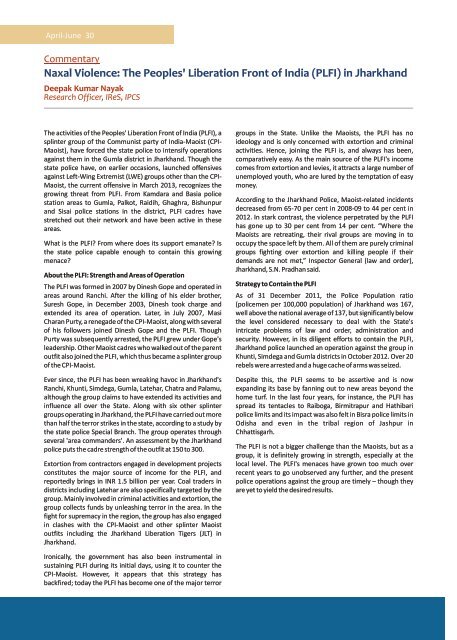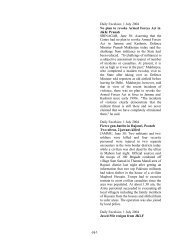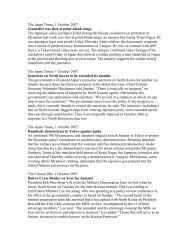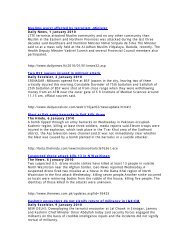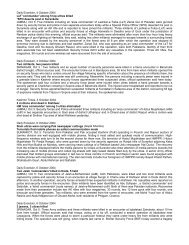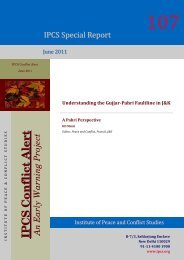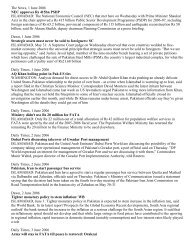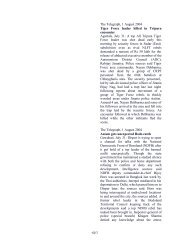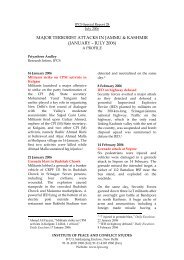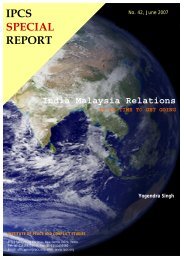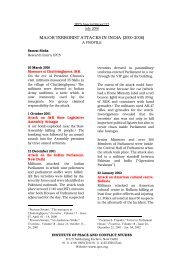April-June 2013 - Institute of Peace and Conflict Studies
April-June 2013 - Institute of Peace and Conflict Studies
April-June 2013 - Institute of Peace and Conflict Studies
You also want an ePaper? Increase the reach of your titles
YUMPU automatically turns print PDFs into web optimized ePapers that Google loves.
<strong>April</strong>-<strong>June</strong> 30<br />
Commentary<br />
Naxal Violence: The Peoples' Liberation Front <strong>of</strong> India (PLFI) in Jharkh<strong>and</strong><br />
Deepak Kumar Nayak<br />
Research Officer, IReS, IPCS<br />
The activities <strong>of</strong> the Peoples' Liberation Front <strong>of</strong> India (PLFI), a<br />
splinter group <strong>of</strong> the Communist party <strong>of</strong> India-Maoist (CPI-<br />
Maoist), have forced the state police to intensify operations<br />
against them in the Gumla district in Jharkh<strong>and</strong>. Though the<br />
state police have, on earlier occasions, launched <strong>of</strong>fensives<br />
against Left-Wing Extremist (LWE) groups other than the CPI-<br />
Maoist, the current <strong>of</strong>fensive in March <strong>2013</strong>, recognizes the<br />
growing threat from PLFI. From Kamdara <strong>and</strong> Basia police<br />
station areas to Gumla, Palkot, Raidih, Ghaghra, Bishunpur<br />
<strong>and</strong> Sisai police stations in the district, PLFI cadres have<br />
stretched out their network <strong>and</strong> have been active in these<br />
areas.<br />
What is the PLFI? From where does its support emanate? Is<br />
the state police capable enough to contain this growing<br />
menace?<br />
About the PLFI: Strength <strong>and</strong> Areas <strong>of</strong> Operation<br />
The PLFI was formed in 2007 by Dinesh Gope <strong>and</strong> operated in<br />
areas around Ranchi. After the killing <strong>of</strong> his elder brother,<br />
Suresh Gope, in December 2003, Dinesh took charge <strong>and</strong><br />
extended its area <strong>of</strong> operation. Later, in July 2007, Masi<br />
Charan Purty, a renegade <strong>of</strong> the CPI-Maoist, along with several<br />
<strong>of</strong> his followers joined Dinesh Gope <strong>and</strong> the PLFI. Though<br />
Purty was subsequently arrested, the PLFI grew under Gope's<br />
leadership. Other Maoist cadres who walked out <strong>of</strong> the parent<br />
outfit also joined the PLFI, which thus became a splinter group<br />
<strong>of</strong> the CPI-Maoist.<br />
Ever since, the PLFI has been wreaking havoc in Jharkh<strong>and</strong>'s<br />
Ranchi, Khunti, Simdega, Gumla, Latehar, Chatra <strong>and</strong> Palamu,<br />
although the group claims to have extended its activities <strong>and</strong><br />
influence all over the State. Along with six other splinter<br />
groups operating in Jharkh<strong>and</strong>, the PLFI have carried out more<br />
than half the terror strikes in the state, according to a study by<br />
the state police Special Branch. The group operates through<br />
several 'area comm<strong>and</strong>ers'. An assessment by the Jharkh<strong>and</strong><br />
police puts the cadre strength <strong>of</strong> the outfit at 150 to 300.<br />
Extortion from contractors engaged in development projects<br />
constitutes the major source <strong>of</strong> income for the PLFI, <strong>and</strong><br />
reportedly brings in INR 1.5 billion per year. Coal traders in<br />
districts including Latehar are also specifically targeted by the<br />
group. Mainly involved in criminal activities <strong>and</strong> extortion, the<br />
group collects funds by unleashing terror in the area. In the<br />
fight for supremacy in the region, the group has also engaged<br />
in clashes with the CPI-Maoist <strong>and</strong> other splinter Maoist<br />
outfits including the Jharkh<strong>and</strong> Liberation Tigers (JLT) in<br />
Jharkh<strong>and</strong>.<br />
groups in the State. Unlike the Maoists, the PLFI has no<br />
ideology <strong>and</strong> is only concerned with extortion <strong>and</strong> criminal<br />
activities. Hence, joining the PLFI is, <strong>and</strong> always has been,<br />
comparatively easy. As the main source <strong>of</strong> the PLFI's income<br />
comes from extortion <strong>and</strong> levies, it attracts a large number <strong>of</strong><br />
unemployed youth, who are lured by the temptation <strong>of</strong> easy<br />
money.<br />
According to the Jharkh<strong>and</strong> Police, Maoist-related incidents<br />
decreased from 65-70 per cent in 2008-09 to 44 per cent in<br />
2012. In stark contrast, the violence perpetrated by the PLFI<br />
has gone up to 30 per cent from 14 per cent. “Where the<br />
Maoists are retreating, their rival groups are moving in to<br />
occupy the space left by them. All <strong>of</strong> them are purely criminal<br />
groups fighting over extortion <strong>and</strong> killing people if their<br />
dem<strong>and</strong>s are not met,” Inspector General (law <strong>and</strong> order),<br />
Jharkh<strong>and</strong>, S.N. Pradhan said.<br />
Strategy to Contain the PLFI<br />
As <strong>of</strong> 31 December 2011, the Police Population ratio<br />
(policemen per 100,000 population) <strong>of</strong> Jharkh<strong>and</strong> was 167,<br />
well above the national average <strong>of</strong> 137, but significantly below<br />
the level considered necessary to deal with the State's<br />
intricate problems <strong>of</strong> law <strong>and</strong> order, administration <strong>and</strong><br />
security. However, in its diligent efforts to contain the PLFI,<br />
Jharkh<strong>and</strong> police launched an operation against the group in<br />
Khunti, Simdega <strong>and</strong> Gumla districts in October 2012. Over 20<br />
rebels were arrested <strong>and</strong> a huge cache <strong>of</strong> arms was seized.<br />
Despite this, the PLFI seems to be assertive <strong>and</strong> is now<br />
exp<strong>and</strong>ing its base by fanning out to new areas beyond the<br />
home turf. In the last four years, for instance, the PLFI has<br />
spread its tentacles to Raiboga, Birmitrapur <strong>and</strong> Hathibari<br />
police limits <strong>and</strong> its impact was also felt in Bisra police limits in<br />
Odisha <strong>and</strong> even in the tribal region <strong>of</strong> Jashpur in<br />
Chhattisgarh.<br />
The PLFI is not a bigger challenge than the Maoists, but as a<br />
group, it is definitely growing in strength, especially at the<br />
local level. The PLFI's menaces have grown too much over<br />
recent years to go unobserved any further, <strong>and</strong> the present<br />
police operations against the group are timely – though they<br />
are yet to yield the desired results.<br />
Ironically, the government has also been instrumental in<br />
sustaining PLFI during its initial days, using it to counter the<br />
CPI-Maoist. However, it appears that this strategy has<br />
backfired; today the PLFI has become one <strong>of</strong> the major terror


